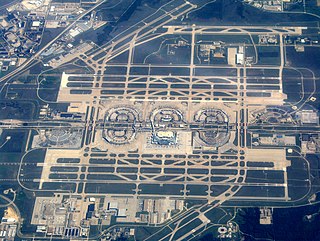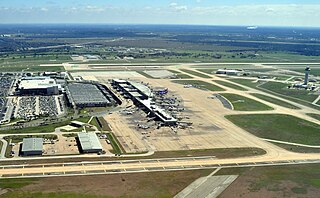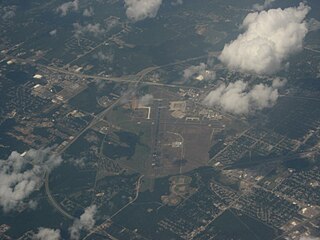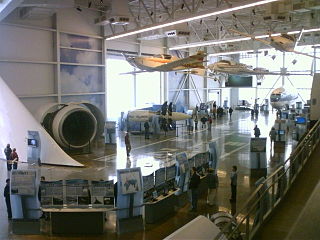
American Airlines is a major airline in the United States headquartered in Fort Worth, Texas, within the Dallas–Fort Worth metroplex. It is the largest airline in the world when measured by scheduled passengers carried, revenue passenger mile, and daily flights. American, along with its regional subsidiaries and contractors operating under the brand name American Eagle, operate an extensive international and domestic network with almost 6,800 flights per day to nearly 350 destinations in 48 countries. American Airlines is a founding member of the Oneworld alliance.

The Boeing 727 is an American narrow-body airliner that was developed and produced by Boeing Commercial Airplanes. After the heavier 707 quad-jet was introduced in 1958, Boeing addressed the demand for shorter flight lengths from smaller airports. On December 5, 1960, the 727 was launched with 40 orders each from United Airlines and Eastern Air Lines. The first 727-100 rolled out on November 27, 1962, first flew on February 9, 1963, and entered service with Eastern on February 1, 1964.

Trans World Airlines (TWA) was a major airline in the United States that operated from 1930 until it was acquired by American Airlines in 2001. It was formed as Transcontinental & Western Air to operate a route from New York City to Los Angeles via St. Louis, Kansas City, and other stops, with Ford Trimotors. With American, United, and Eastern, it was one of the "Big Four" domestic airlines in the United States formed by the Spoils Conference of 1930.

Dallas Fort Worth International Airport is the primary international airport serving the Dallas–Fort Worth metroplex and the North Texas region, in the U.S. state of Texas.

Austin–Bergstrom International Airport, or ABIA, is an international airport in Austin, Texas, United States, serving the Greater Austin metropolitan area. Located about 5 miles southeast of downtown Austin, it covers 4,242 acres (1,717 ha) and has two runways and three helipads.

Seattle–Tacoma International Airport is the primary international airport serving Seattle and its surrounding metropolitan area in the U.S. state of Washington. It is in the city of SeaTac, which was named after the airport's nickname Sea–Tac, approximately 14 miles (23 km) south of downtown Seattle and 18 miles (29 km) north-northeast of downtown Tacoma. The airport is the busiest in the Pacific Northwest region of North America and is owned by the Port of Seattle.

Fort Wayne International Airport lies eight miles southwest of Fort Wayne, in Allen County, Indiana, United States. It is owned by the Fort Wayne-Allen County Airport Authority.

Key West International Airport is an international airport located in the City of Key West in Monroe County, Florida, United States, 2 miles east of the main commercial center of Key West.

Corpus Christi International Airport is 6 miles west of Corpus Christi, in Nueces County, Texas. It opened in 1960, replacing Cliff Maus airport at 27.767°N 97.44°W, where the Lozano Golf Center is now located.

The Evergreen Aviation & Space Museum is an independent, 501(c)(3) non-profit, aviation museum in McMinnville, Oregon. Its exhibits include the Hughes H-4 Hercules and more than fifty military and civilian aircraft, unmanned aerial vehicles (drones), and spacecraft. The museum complex includes four main buildings: the original aviation exhibit hall, a large screen digital theater, a second exhibit hall focused on space technology, and a water park.

The Museum of Flight is a private non-profit air and space museum in the Seattle metropolitan area. It is located at the southern end of King County International Airport in the city of Tukwila, immediately south of Seattle. It was established in 1965 and is fully accredited by the American Alliance of Museums. As the largest private air and space museum in the world, it also hosts large K–12 educational programs.

The National Museum of the United States Air Force is the official museum of the United States Air Force located at Wright-Patterson Air Force Base, six miles (9.7 km) northeast of Dayton, Ohio. The NMUSAF is the oldest and largest military aviation museum in the world, with more than 360 aircraft and missiles on display. The museum is a central component of the National Aviation Heritage Area. The museum draws about a million visitors each year, making it one of the most frequently visited tourist attractions in Ohio.

Manhattan Regional Airport in Riley County, Kansas, United States, is the second-busiest commercial airport in Kansas. Owned by the city of Manhattan, Kansas, the airport is located about five miles southwest of downtown Manhattan. American Airlines via its American Eagle affiliate serves the airport with five daily regional jet flights, with two nonstops to Chicago O'Hare International Airport (ORD) and three nonstops to Dallas/Fort Worth International Airport (DFW). The airport also accommodates general aviation and charter flights for the military and college sports teams, being conveniently located four miles east of Fort Riley and eight miles southwest of Kansas State University's athletic complex).

Fort Smith Regional Airport is a public use airport located near the Interstate 540 freeway three nautical miles (6 km) southeast of the central business district of Fort Smith, in Sebastian County, Arkansas, United States. FSM is governed by the Fort Smith Airport Commission as established by the City of Fort Smith, Arkansas. It serves the transportation needs of residents and businesses of western Arkansas and eastern Oklahoma. FSM is currently served by American Eagle, the regional airline affiliate of American Airlines. It has a large population of corporate and general aviation aircraft. A full-service fixed-base operator (FBO), Signature Flight Support, provides service to general aviation, airline, and military operators.

Shreveport Regional Airport is a public use airport in Shreveport, Louisiana, United States. It is owned by the City of Shreveport and located four nautical miles (7 km) southwest of its central business district.

The Future of Flight Aviation Center, officially known as Boeing Future of Flight, is an aviation museum and education center located at the northwest corner of Paine Field in Mukilteo, Washington. It is the starting point for the Boeing Tour, a guided tour of a portion of the nearby Boeing Everett Factory in Everett, Washington. The 73,000-square-foot (6,800 m2) facility, owned by Snohomish County via Paine Field and operated by Boeing, opened in 2005 at a cost of $24 million; it is funded by a sales and use tax from the county via its public facilities district. The museum includes a 28,000-square-foot (2,600 m2) gallery containing static and interactive exhibits and displays as well as a 240-seat theater, café and shops.

Downtown Tampa is the central business district of Tampa, Florida, United States, and the chief financial district of the Tampa Bay Area.
UPS Airlines is a major American cargo airline based in Louisville, Kentucky, US. One of the largest cargo airlines worldwide in terms of freight volume flown, UPS Airlines flies to 815 destinations worldwide. It has been a wholly owned subsidiary of United Parcel Service since its launch in 1988.
Sciencenter is a hands-on science museum in Ithaca, New York. It was founded on February 28, 1983 as a 501(c)(3) not-for-profit educational organization. The Sciencenter grew out of the volunteer-run hands-on science program run for 15 years at several elementary schools in the Ithaca City School District. The community-based tradition continued as the museum grew to be nationally known, despite not having a paid staff until the 1990s. The Sciencenter is accredited by the American Alliance of Museums (AAM), and is a member of the Association of Science-Technology Centers (ASTC) and Association of Children's Museums.

Robert Mueller Municipal Airport was the first civilian airport built in Austin, Texas, United States. It was located a few miles northeast of downtown Austin. It was replaced as Greater Austin's main airport by the Austin–Bergstrom International Airport, which is located on the site of the former Bergstrom Air Force Base. The airport was named after Robert Mueller, a city commissioner who died in office in January 1927. Robert Mueller Municipal Airport was identified with the airport code AUS, which was reassigned to Austin–Bergstrom International Airport in 1999.





















